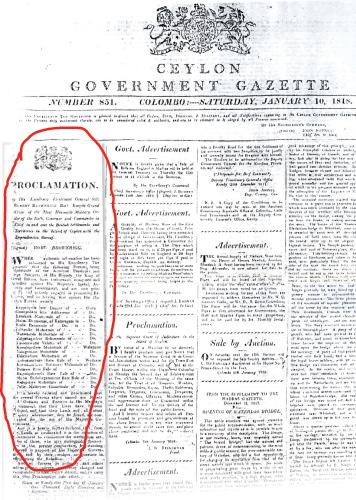
The 1818 Uva-Wellassa uprising was the third Kandyan uprising against the British during the period of Governor Robert Brownrigg. After the Northern Lords signed an agreement with the British colonials in Ceylon, on March 2, 1815, there were those who opposed British rule and organized a freedom movement. They were captured after their failed uprising in 1818, and consequently executed and declared as traitors, for rebelling against the King of England, and their property confiscated. Thus, they remained till today.
 Following a recommendation from the Minister of Justice, Wijeyadasa Rajapakshe, President Maithripala Sirisena issued a special decree on Thursday (8) to overturn the proclamations declared in the Ceylon Government Gazette No 851 of January 10, 1818, and decriminalize the 19 nationals, including Monarawila Keppetipola, who led the movement, and declare them national heroes. The Ministry of Justice spokesperson said, the decree will be followed by another gazette notification.
Following a recommendation from the Minister of Justice, Wijeyadasa Rajapakshe, President Maithripala Sirisena issued a special decree on Thursday (8) to overturn the proclamations declared in the Ceylon Government Gazette No 851 of January 10, 1818, and decriminalize the 19 nationals, including Monarawila Keppetipola, who led the movement, and declare them national heroes. The Ministry of Justice spokesperson said, the decree will be followed by another gazette notification.
It was not a rebellion, it was the first ever struggle for the independence of Ceylon, Prof. Emeritus Malini Handagama, former senior Prof of History, Sri Jayawardenapura University said. “That is the first mistake we make. It was not a rebellion, they simply wanted independence.” Those who have studied the Uwa-Wellassa freedom struggle have been struggling to clear the names of these heroes for some time, Handagama said, and although it took a long time, finally, it has been done.
The names cleared are: Keppetipola Disawe, Godagedara Rate Adhikaram, Ketakala Mohottale, Katharagama Maha Bethme Rate rala, Katharagama Kuda Bethme Rate rala, Palangolle Mohottala, Wattekaale Mohottala, Polgahagedara Rehehenaraale, Poserewatte Vidane, Kiwulegedara Mohottala, Kalugamuwe Mohottala, Udumadura Mohottala, Kohukumbura Walauwe Raterala, Kohukumbura Walauwe Mohottala, Butewe Rate rala, Bhaginigahawela Rate rala, Mahabadulla Gammane Rate rala, Bulupitiye Mohottala and Palle Malheyaye Gamathirala.
Three years after the signing of the Kandyan Convention, British rule proved to be disappointing and the local lords began to complain of violation of conditions in the Convention. The 1818 rebellion begins with Governor Brownrigg refusing to place a Kandyan on the throne and grant administrative powers to the local lords, as previously agreed. This breach of agreement and other actions of the Governor are said to have been questioned in the British Parliament as well.
In 1817, a layman from Kataragama claimed the Kandyan throne and started a freedom march to Kandy, which other Rate Ralas supported. This was attacked by the British armies, and one such troop was led by Sylvester Douglas Wilson, the Assistant Resident in Badulla. Butewe Rate Rala, whose name is included in the list, was the one time hero who shot Wilson with an arrow, from the top of a rock, when the troops marched past a small town near Bibile, called Yalkumbura. The armies scattered on the death of their leader. However, it is reported that Governor Brownrigg sent special platoons to look for the person who killed Wilson.
History doesn’t elaborate on the contribution of the rest of the rebels in the list as much as it dotes on Keppetipola Disawe. The famous of the rebels is Monarawila Keppetipola, a lord in the Kandyan Kingdom, representing the Uva area, who was sent to stop the uprising by the British government after the attack on Wilson, but ended up joining the freedom struggle instead, as its leader. A famous version about him says, he marched towards the ‘rebels’ with the British army, and without any prior hint, gave an order to the army to retreat and joined the ‘rebels’. He is celebrated for his actions in Sri Lanka.
During the 1818 uprising, the ‘rebels’ captured Kandy and Matale before Keppetipola fell ill and according to history books, was captured on October 28, 1818 along with Pilimathalawe Disawa, another ‘rebel’ leader. It is said that they were captured by Captain O’Neil of the British army with the assistance of Native Lieutenant Cader-Boyet of the Ceylon Rifle Regiment. When his house was surrounded by the troops, it is said that Keppetipola boldly came out of the house and greeted Capt O’Neil, identified himself and gave himself in. History narrates that the valiant Keppetipola, with the rest of the ‘rebels’ captured, refused to seek pardon from the British, though the latter was willing to pardon had they asked for it. Instead, it is said, Keppetipola pointed the exact location on his neck, to the executioner, where he needed the head to be severed.
“The destruction caused to property, cultivated lands and people’s lives and lifestyles, with villages being wiped out driving people into forests, was so severe that the Uva Province is still recovering from the destruction”, Prof. Handagama said. People were robbed of their property and taxes imposed to suppress them further. “The Uva Province is still considered laid back. The local leaders too have failed to support the area after independence in 1948, to return the lands once robbed, to the families, rebuild irrigation systems to its former glory, and pay reparations for all they lost, harbouring the first struggle for independence in Ceylon,” she said.
